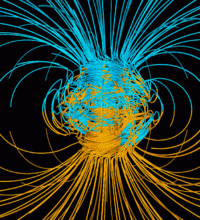
Photo from wikipedia
The present work has mathematically modeled the peristaltic flow in nanofluid by using thermal radiation, induced a magnetic field, double-diffusive convection, and slip boundary conditions in an asymmetric channel. Peristalsis… Click to show full abstract
The present work has mathematically modeled the peristaltic flow in nanofluid by using thermal radiation, induced a magnetic field, double-diffusive convection, and slip boundary conditions in an asymmetric channel. Peristalsis propagates the flow in an asymmetric channel. Using the linear mathematical link, the rheological equations are translated from fixed to wave frames. Next, the rheological equations are converted to nondimensional forms with the help of dimensionless variables. Further, the flow evaluation is determined under two scientific assumptions: a finite Reynolds number and a long wavelength. Mathematica software is used to solve the numerical value of rheological equations. Lastly, the impact of prominent hydromechanical parameters on trapping, velocity, concentration, magnetic force function, nanoparticle volume fraction, temperature, pressure gradient, and pressure rise are evaluated graphically.
Journal Title: Nanomaterials
Year Published: 2023
Link to full text (if available)
Share on Social Media: Sign Up to like & get
recommendations!